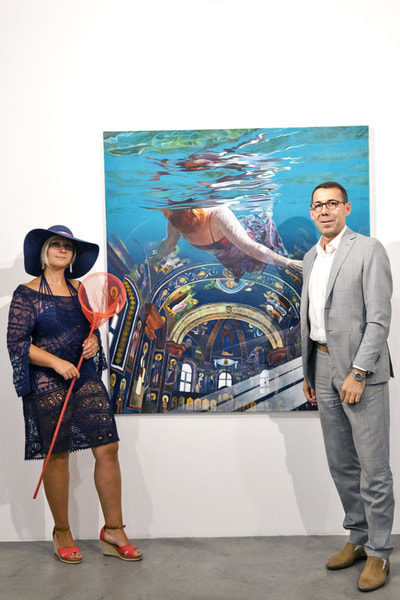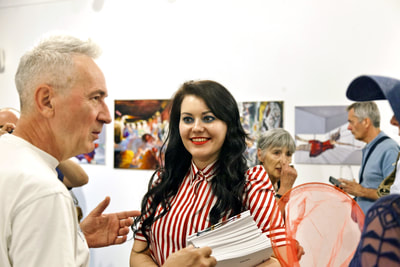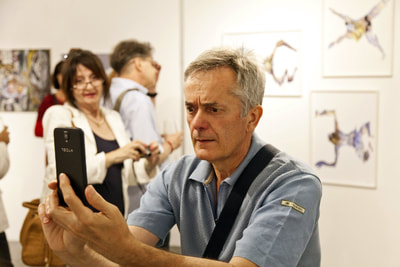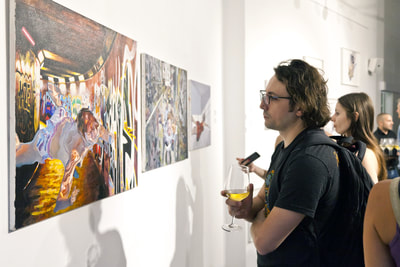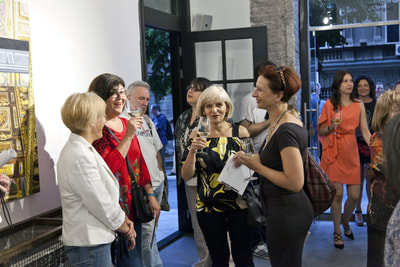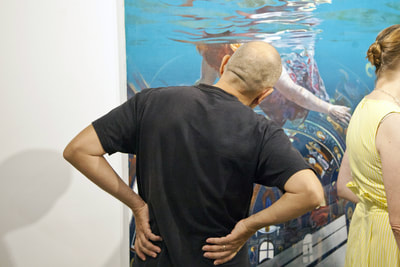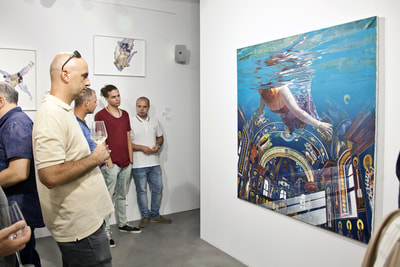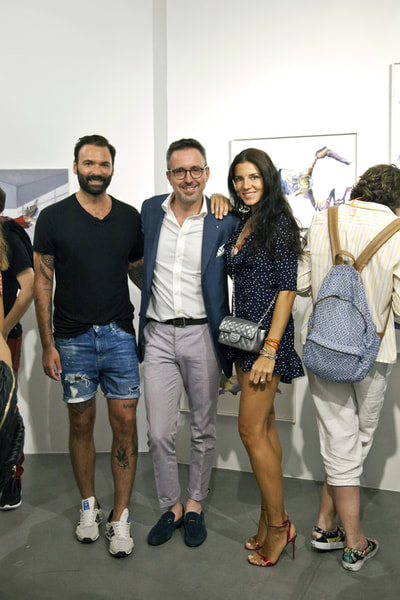Underwater
14.07.-12.08.2017. Drina Gallery Belgrade
Ever since the pivotal moment of Malevich’s Black Square signaling the break between representational and abstract painting, artists have been returning to figuration disguised as a metaphor, as an amalgamation of intellectual exploration and hyperreal self-gaze: both an eye-pleaser and a text.In the age of social media apps that narrate (auto)biographical stories with their hourly illustrations, our optic nerve takes in a barrage of bodies-like-us storming the citadel of empathy, fighting to embed its message and provoke reaction, gain popularity and propagate further. We spend our days floating in reference pools of augmented reality, the soft blend of interactive, technologically manufactured virtual spaces and the absurdly manufactured “real world”.
In this space art mimics reality, in the sense of following rather than leading, the manufactured world. The representational image is rarely truly iconoclastic, but rather a clever pastiche or an analogy. The post- visual orthodoxy seems to be to draw from a very large pool of references, all the better to hide its own confusion, or the inability to balance the critical-polemical with the visual. Instead, it seeks to spark a wide following: a Trojan Horse that penetrates the furthest. In this sense, representation is on the gain again, all other historical “isms” propping it up as filters flimsily obfuscating the ubiquitous selfie.
The art of Ivana Živić (1979) observes the world of emotions – artist’s own but also ours – through the lens and a metaphor of water. The element of water lends itself as a time-honoured way to describe internality through the gamut of its representations: flow, current, rush; power and surge, turbulence or a smooth glide; drive or dive. The often solitary figure of a swimmer is the character that experiences, and becomes, the story.
Technically a very adept painter, Živić doesn’t discuss the uncomfortable topics of the world around us, instead choosing to reference her emotions through a highly aestheticised set of metaphoric chambers through which the body of a swimmer moves, flies, dives with natural ease. The two elements of the story – the swimmer and the chambers – are positioned as a natural response to an unnatural situation: the spaces appear fixed and real, whereas the swimmer appears fluid and dreamlike, an astronaut cruising its own universe. While the rooms reference various spaces of traditional and social richness (from the rooms of Versailles palace in Golden Room or the graffiti-clad walls in Metro and Breath), they do so in the manner of gilded aquariums. The opulence of style and technical rendering that make her work so visually appealing, capitalising on the fascinating detail of their backgrounds styled (collected?) to impress, cover up the work’s critical lightweight. They don’t really have a wide or impactful message, other than being a beautiful depiction of a deeply commodified world in which emotions float and battle almost without leaving a trace.
The distinction between the rich chambers of Music and Golden Room and the quiet inner spaces of Butterfly III and a series Swimmers is made greater by the powerful surge of swimmers freed from the clamour of their gilded cages. The artist’s inner world is at its most audible in the series of pastel drawings Swimmers, left with an austere white background, or in the paintings Butterfly II and Butterfly III, where the figure in a red dress floats within the white-walled restraints of a canvas. This could be a liberating inner space or the constraints of an asylum – the decision is left to us.
With Živić, her painterly skill outweighs criticality. She is a talented painter clearly and generously enjoying her craft, and the viewer shares in her enjoyment. Does art need to work harder to justify the gilt-laden show of skill with a matched critical observation that goes beyond the metaphor? Perhaps for Živić the opportunity presents itself in those “empty” white-walled works, templates of unrestrained and joyful self-awareness set apart from the more stylised and richer works. While the chambers willingly take one’s breath away, encouraging passiveness (even a sense of drowning) in a viewer, the freed swimmer that has nowhere to hide truly reflects and illuminates the everyday truth of the artist. She has a wide berth of water ahead of her.
Aleksandra Lazar
In this space art mimics reality, in the sense of following rather than leading, the manufactured world. The representational image is rarely truly iconoclastic, but rather a clever pastiche or an analogy. The post- visual orthodoxy seems to be to draw from a very large pool of references, all the better to hide its own confusion, or the inability to balance the critical-polemical with the visual. Instead, it seeks to spark a wide following: a Trojan Horse that penetrates the furthest. In this sense, representation is on the gain again, all other historical “isms” propping it up as filters flimsily obfuscating the ubiquitous selfie.
The art of Ivana Živić (1979) observes the world of emotions – artist’s own but also ours – through the lens and a metaphor of water. The element of water lends itself as a time-honoured way to describe internality through the gamut of its representations: flow, current, rush; power and surge, turbulence or a smooth glide; drive or dive. The often solitary figure of a swimmer is the character that experiences, and becomes, the story.
Technically a very adept painter, Živić doesn’t discuss the uncomfortable topics of the world around us, instead choosing to reference her emotions through a highly aestheticised set of metaphoric chambers through which the body of a swimmer moves, flies, dives with natural ease. The two elements of the story – the swimmer and the chambers – are positioned as a natural response to an unnatural situation: the spaces appear fixed and real, whereas the swimmer appears fluid and dreamlike, an astronaut cruising its own universe. While the rooms reference various spaces of traditional and social richness (from the rooms of Versailles palace in Golden Room or the graffiti-clad walls in Metro and Breath), they do so in the manner of gilded aquariums. The opulence of style and technical rendering that make her work so visually appealing, capitalising on the fascinating detail of their backgrounds styled (collected?) to impress, cover up the work’s critical lightweight. They don’t really have a wide or impactful message, other than being a beautiful depiction of a deeply commodified world in which emotions float and battle almost without leaving a trace.
The distinction between the rich chambers of Music and Golden Room and the quiet inner spaces of Butterfly III and a series Swimmers is made greater by the powerful surge of swimmers freed from the clamour of their gilded cages. The artist’s inner world is at its most audible in the series of pastel drawings Swimmers, left with an austere white background, or in the paintings Butterfly II and Butterfly III, where the figure in a red dress floats within the white-walled restraints of a canvas. This could be a liberating inner space or the constraints of an asylum – the decision is left to us.
With Živić, her painterly skill outweighs criticality. She is a talented painter clearly and generously enjoying her craft, and the viewer shares in her enjoyment. Does art need to work harder to justify the gilt-laden show of skill with a matched critical observation that goes beyond the metaphor? Perhaps for Živić the opportunity presents itself in those “empty” white-walled works, templates of unrestrained and joyful self-awareness set apart from the more stylised and richer works. While the chambers willingly take one’s breath away, encouraging passiveness (even a sense of drowning) in a viewer, the freed swimmer that has nowhere to hide truly reflects and illuminates the everyday truth of the artist. She has a wide berth of water ahead of her.
Aleksandra Lazar






